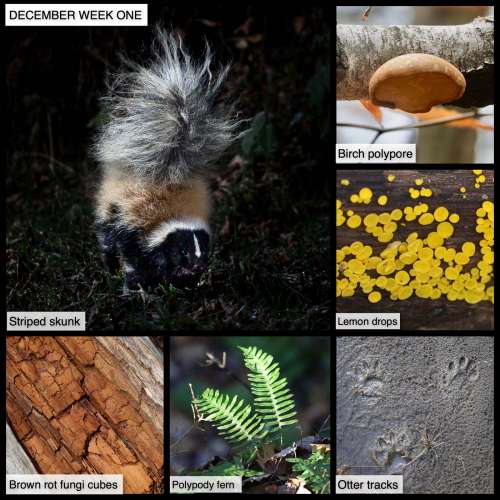This Week in the Woods, we’re sharing the third installment in our apple orchard photography project: a striped skunk who, based on its defensive posture, looks less-than-pleased to have its grubbing interrupted by surprise flash photography. As noted in this profile from Vermont Fish & Wildlife, skunks will den up and even share winter shelter to conserve body heat, but they don’t hibernate. These beautiful-but-stinky members of the weasel family tend to cause alarm when they appear (especially among dog owners), but as our camera trapping shows, they’re common night-time visitors to lawns and fields. Because they eat a lot of beetle larvae, skunks are an excellent source of organic pest control. Often the only sign you’ll see that they’ve passed by is small snoot hole in the grass and leaves.
Here are some other nature sights (clockwise):
Those puffy pancake-looking shelf fungi growing on birch trees are birch polypores. They typically grow in a group, arrayed up and down the trunk of a dead or sickly birch. As we noted in a 2020 post about the fungi, birch polypores have a long history of medicinal uses. These fungi have been used since ancient times, as evidenced by the 5,300 year-old remains of Ötzi the Iceman, discovered by hikers in the Tirolean Alps, who was found with both birch polypore and tinder polypore in his clothing. (As the name implies, tinder polypore has also served as fire-starting material.)
Tiny but abundant lemon drops, which also go by the names “yellow fairy cups” and “lemon disco,” grow on the rotting logs of both hardwoods and conifers. Although they appear summer through autumn, it’s now, in the drab days of stick season, that they’re most noticeable. As noted in Teresa Marrone and Walt Sturgeon’s field guide Mushrooms of the Northeast, “Like other Cup Fungi…the spores are produced on the inner surface of the saucer.”
Tig Tillinghast found these river otter tracks on a beach along the Ompompanoosuc River. One of the tells that this is a mustelid (weasel family) track is the C shape of the palm. You can also (barely) see the elongated foot shape in the top right track. This Tracking Tips column by Susan Morse from the Summer 2016 issue of Northern Woodlands magazine explains how to distinguish otter tracks from those of raccoon, another common five-toed streamside visitor.
Although most ferns have gone by, polypody ferns will remain green all winter long, and as this photo shows, they can really shine when they catch the light on a sunny December day. These scrappy little ferns often appear in cliffy spots or grow in thin soils atop boulders. They get their name from their habit of spreading by branching “feet,” or rhizomes. This profile from The Native Plant Trust, notes there are two polypody species in our region: rock polypody and Appalachian polypody. The latter has a somewhat more triangular-shaped frond and a more pointed apex (tip at the top), but it’s a subtle difference.
Why does decaying wood sometimes look like stacked boxes, as shown in this image? As explained by Rachel Sargent Mirus in this recent Outside Story essay, the wood has probably been infected by brown rot fungi, a general category of fungal wood recyclers that includes mushroom celebrity chicken-of-the-woods. According to Sargent Mirus, “Brown rot fungi consume the cellulose and hemicellulose, snipping those molecules down to their component sugars, which the fungi then absorb. Brown lignin is left behind, and the decayed wood tends to crack into cubes.” Check out the full article for an interesting overview of fungal wood coloring.
Our thanks to The Bailey Charitable Foundation and the Frank and Brinna Sands Foundation for helping to support this series.
In this difficult period, many of us find joy in observing local nature. This series, launched in April 2020, shares nature photographs taken in the past seven days, or in the same week in 2020, most within 15 miles of the Northern Woodlands office in Lyme, New Hampshire. We hope you enjoy using this grid as a prompt for your own explorations.
What are you seeing in the woods this week? Share your images with us on Facebook, or submit a special photo for possible inclusion in our monthly online Reader Photo Gallery.


